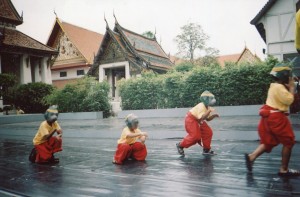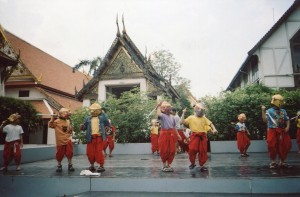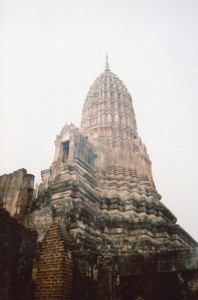From the 11th to the 13th century the Khmers ruled about half of Thailand, but Thais became independent in the 13th century and they formed their own states. This is very cool because–
people in Pisa, Italy were building their greatest monuments at the same time. Thai culture and the Italian Renaissance developed at the same time, and both make up one of the most enjoyable cultural comparisons I’ve ever found. The last 3 posts focused on the Italian Renaissance’s role in strengthening Western culture. But on the other end of Eurasia, an equally fascinating culture flowered.
In the above shot, kids rehearse for a performance of the Ramayana. They’re playing soldiers in Hanuman’s monkey army, which helped Rama win back his kingdom. I was too full of delicious food to join, so I watched the performance blend with the beautiful buildings and natural surroundings with perfect contentment. Thais call this feeling sabai. It means a mellow happiness. It often refers to sitting with your best friends and chatting after dinner.
These blends of art-forms and nature sure don’t look like Italian Renaissance art. The buildings in Florence and Pisa emphasize clear and straight geometric forms, like lines and arches. Westerners have seen simple and permanent forms as models of truth and order since ancient Greece.
But the forms in the above photos are as irreducible as Thailand’s tropical natural environment. On one hand, they’re animated, but on the other, they’re graceful. The sinuous lines of the buildings’ roofs, and the restrained dances in a performance with a violent theme tame nature’s power so people can live happily in it.
States all over Southeast Asia adapted the Ramayana as models of order. Rama represents refinement, civility and goodness. The antagonist which he fought with the monkey army’s help was Ravana. He represents the wild forces of nature which must be tamed.
Thailand’s theatrical performances and its architecture seem to pulsate with the energies that infuse the tropics, but their forms also gently ripple like a river. The Buddhist prang in the above shot at Si Satchanalai follows this aesthetics too. Thais blended Hindu and Buddhist traditions into their own patterns while the Italian Renaissance was emphasizing forms from ancient Greece and Rome.
The feeling of sabai reflects these patterns. It’s not intense, and it’s not centered on one thing. It’s more of a general feeling that blends harmony with the whole environment and mild stimulation. Thais have created endless variety of these mixtures in their architecture, sculpture, theater, painting and personal behavior. You can’t order it fully like Roman arches, but you never run out of variations to savor. We’ll see more Thai culture in the next 2 weeks, and we’ll compare it with the Italian Renaissance. Two supremely beautiful artistic traditions side-by-side. Sabai indeed!




Comments on this entry are closed.